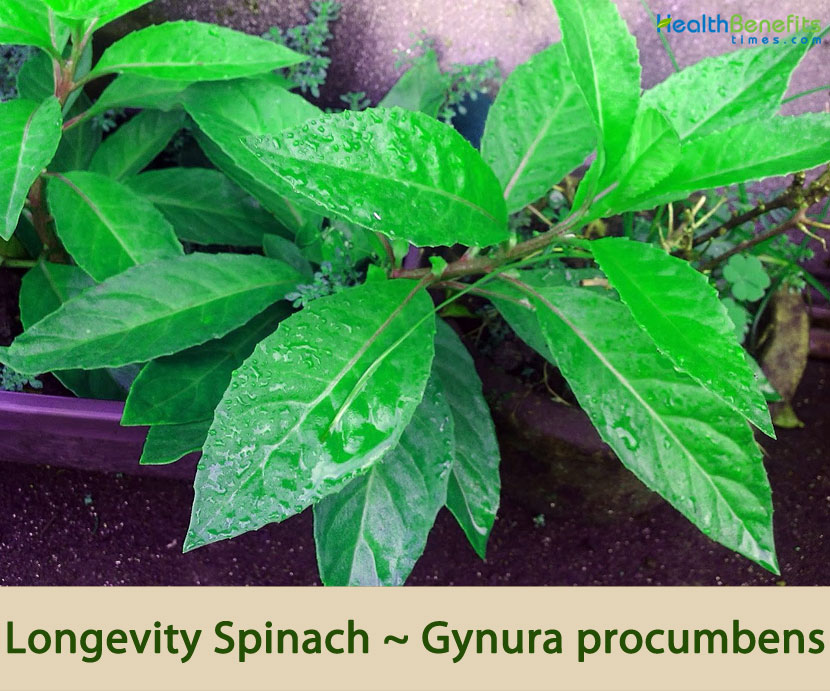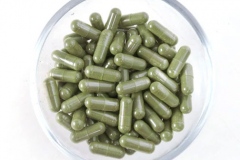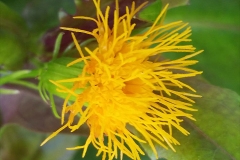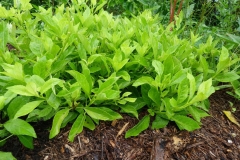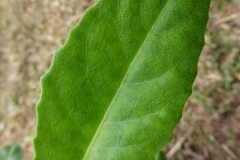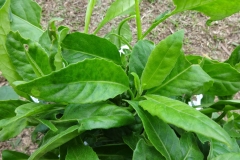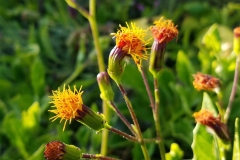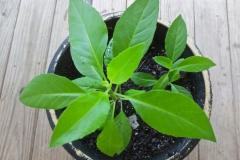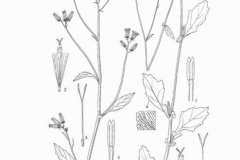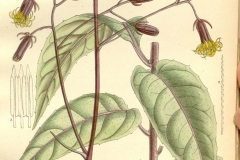| Longevity Spinach Quick Facts | |
|---|---|
| Name: | Longevity Spinach |
| Scientific Name: | Gynura procumbens |
| Origin | China, Thailand, Indonesia, Malaysia, Vietnam and Africa |
| Shapes | Smooth, tiny cylindrical, ribbed seed-capsules |
| Taste | Taste somewhat similar to Malabar spinach |
| Health benefits | Diabetes, May improve fertility, Helps treat certain infections, May reduce inflammation, May promote wound healing, Heart disease, Anticancer activity, Hemorrhoids, Menstrual Disorders, Treat Bleeding or Swelling of the Breast, Blackheads, Stroke, Rheumatism, Hypertension, Wounds, Heal warts, Ganglion, Cough and Vomiting Blood, Dengue Fever, Sprains, May protect against organ and tissue damage, Treat from bites of wild animals, Treat Seizures in Children |
| Name | Longevity Spinach |
|---|---|
| Scientific Name | Gynura procumbens |
| Native | China, Thailand, Indonesia, Malaysia, Vietnam and Africa |
| Common Names | Longevity Spinach, Sambung Nyawa, Longevity Greens, Akar sebiak, Akar, Bau dat, Daun dewa, Ebure, Gipoi, Kacham akar, Kelemai merah, Kim that, Phti angkam, Rau hung lui, Sambung nyawa, Mollucan Spinach, Leaves of the Gods, Bai Bing Ca, Sambung, Scrambling gynura, Velvet plant |
| Name in Other Languages | Cambodia: Chi angkam Chinese: Píng wò jú sān qī (平卧菊三七), Man san qui cao, Lam fei yip, Bai bing ca, Ping wo ju sam qi, Akar Sebiak, Kelemai Mearh, Nan fei Ye, Bai Bing Ca English: Scrambling gynura Finnish: Köynnössamettilehti Indonesian: Sambung nyawa, akar sebiak, kelemai merah, Daun Dewa Javanese: Sambung nyawa (tetuwuhan) Malaysia: Deva raja, Akar sebiak, Kacham akar, Mollucan spinach, Sambung Nyawa Persian: گینورا سارمنتوزا Swedish: Blekt sammetsblad Tagalog: Sabungai, Kamangi Thai: Paetumpung (แป๊ะตำปึง) United States: Longevity spinach Vietnam: Kim That Tai, Cai Tieu Duong, Tiem Vinh |
| Plant Growth Habit | Wide-spreading, low-growing, robust glabrous herbaceous, semi-succulent plant |
| Growing Climates | Tropical forests and bushes, thickets, streams in forests, sandy slopes, climbing on shrubs or trees, meadows, near streams, or other wet but well drained soils |
| Soil | Prefers well-drained soil and can grow in nutritionally poor soil. Keep the soil moist but not soggy, as too much water might cause root rot |
| Plant Size | 0.8 m (2.6 ft.) tall |
| Stem | Procumbent, brownish or purple striate, glabrous or pubescent when young, branched |
| Leaf | Ovate-elliptic or lanceolate, leaf blades measure up to 3.5 to 8 centimeters (1.3 to 3.14 inches) long and are 0.8 to 3.5 centimeters (0.3 to 1.3 inches) wide. Leaves are purplish on the underside while dark glossy, greenish on the upper surface |
| Flower | Flowering heads are panicled, narrow, yellow, and 1 to 1.5 centimeters long. Involucral bracts are smooth and up to 6 millimeters long. |
| Fruit Shape & Size | Smooth, tiny cylindrical, ribbed seed-capsules with very close and slender ribs each containing a single seed. |
| Taste | Taste somewhat similar to malabar spinach |
| Propagation | By Seed, Stem Cutting |
| Plant Parts Used | Whole plant, leaves, shoots |
| Products containing | Coffee powder Kimchi Tea Chocolate Candies Chewing gums Oral sprays Hand sanitizers Skin creams Facial masks etc |
| Health Benefits |
|
| Precautions |
|
Plant Description
Longevity Spinach is a wide-spreading, low-growing, robust, glabrous, herbaceous, semi-succulent plant that normally grows up to 0.8 m (2.6 ft.) tall and is much-branched, with long stems that start erect then twine and climb up structures, or creep along the ground to lengths of up to 5 m (16 ft.). Longevity spinach vines tend to creep along the ground and may form a thick ground cover. The stems tips are soft and succulent, the rest of the stem semi-woody. The bark is green, purple or mottled. The plant is found growing in tropical forests and bushes, thickets, streams in forests, sandy slopes, climbing on shrubs or trees, meadows, near streams, or other wet but well drained soils. Normally the plant prefers well-drained soil and can grow in nutritionally poor soil. Keep the soil moist but not soggy, as too much water might cause root rot.
Leaves
Fleshy and smooth longevity spinach leaves are ovate-elliptic or lanceolate with shallow teeth along the leaf margin. Generally, leaf blades measure up to 3.5 to 8 centimeters (1.3 to 3.14 inches) long and are 0.8 to 3.5 centimeters (0.3 to 1.3 inches) wide. Leaves are purplish on the underside while dark glossy, greenish on the upper surface; glabrous (smooth), base rounded or attenuate, apex acute to acuminate. They are alternately arranged along the stems and remain on the plant throughout the year.
Flowers
Flowers are small and thistle-like with orange filaments. They are self-pollinating and come into bloom in spring, borne in loose clusters of only a few, though are sometimes not produced. Flowering heads are panicled, narrow, yellow, and 1 to 1.5 centimeters long. Involucral bracts are smooth and up to 6 millimeters long.
Fruits
Fertile flowers are followed by smooth, tiny cylindrical, ribbed seed-capsules with very close and slender ribs each containing a single seed.
Health benefits of Longevity Spinach
Longevity Spinach consists of multitude vitamin and minerals. Let us take a look at the health benefits of the longevity spinach for your health and what it’s suitable for. Some popular health benefits of Longevity spinach as listed below:
1. Diabetes
Diabetes is a disorder caused when sugar levels in your blood exceed its limit. You should care for your diabetes immediately to prevent its complications. Research concluded that longevity spinach can induce a hypoglycemic effect in diabetic animals. It has been verified to considerably reduce fasting blood sugar levels and reduce glucose spike during glucose tolerance test in diabetic rats but not normal rats. You may drink the potion in the stew of longevity spinach leaves once every day for better result.(1), (2)
2. May improve fertility
Infertility is one of the complications of diabetes. Gynura may treat infertility in diabetics. Few animal studies demonstrated that the administration of longevity spinach helps improve fertility by increasing enzymatic activity, sperm count, and sperm motility. It also reduces the percentage of sperm mortality and promotes sperm maturation. It also has aphrodisiac properties like ashwagandha and increased mounting frequency in rats. Human research is required to understand if longevity spinach can show the same effects in humans too.(3)
3. Helps treat certain infections
Longevity spinach can help treat or manage certain diseases and infections due to its antibacterial, antiviral, and antifungal activity. The ethanolic extract of aerial plant parts of Gynura has been demonstrated to deactivate or destroy viruses. It also prevents the replication of viruses like the herpes simplex virus. It also shows antibacterial activities against gram-positive and gram-negative bacteria like Salmonella typhi, Staphylococcus aureus, Bacillus cereus, Vibrio parahaemolyticus, and Pseudomonas aeruginosa. It also exhibits antifungal activity against fungi like Aspergillus Niger and Candida albicans.(4), (5)
4. May reduce inflammation
Longevity spinach is commonly used to treat inflammation in Thai folk medicine. It consists of ꞵ-caryophyllene, β-pinene, limonene, and 3-carene, all of which are reported to have anti-inflammatory properties. Longevity spinach extract may be used topically in treating inflammatory conditions like atherosclerosis. (6)
5. May promote wound healing
Longevity spinach has been used as a traditional medicine in southern china. Mashed Gynura was applied topically for relieving red swelling, fever of the skin and also for treating poisonous insect bites. Topical application of its extract can also promote wound healing by activating cells involved in wound healing. Applying Gynura extract topically can decrease scar width and show signs of dermal healing. It is also important in pain management.(7), (8)
6. Heart disease
Heart disease is caused when blood flow into the heart stops even in only a couple of seconds. Some factors that can result in heartache are; smoking, alcohol, obesity, lack of rest and less exercise. Natural way to decrease the probability of heartache is by frequently drink the potion made of mashed up harvest tubers and massaging it with water.
7. Anticancer activity
Longevity spinach has long been used as a traditional treatment for leukemia, uterine, and breast cancers. This discovery has led to numerous kinds of research on the anti-cancer benefits of longevity spinach. Research has concluded that longevity spinach appears to be an effective chemotherapeutic agent against a wide range of cancer cell types. It exerts its anticancer activities via the modulation of various points of carcinogenesis including cancer initiation, cell proliferation, metastasis, and angiogenesis.
8. Hemorrhoids
Longevity spinach leaves are considered quite beneficial for treating hemorrhoids. To deal with psoriasis, you can drink a potion in the stew of longevity spinach leaves blended with aloe Vera and a bit of honey. However, if your hemorrhoids are aggravated, then you can take some leaves of strength spinach, and then squeeze to remove the sap, and then insert it into your anus.
9. Menstrual Disorders
Normally, most girls are disturbed by their irregular menstrual cycles. However, longevity spinach leaves are beneficial in overcoming this disorder. To deal with menstrual disorder, drink a portion in the stew or mashed up the foliage of longevity spinach leaves blended with small arrack that’s been heated.
10. Treat Bleeding or Swelling of the Breast
Bleeding or Swelling of the Breast can cause painful sensation in your breast. This can be caused by a number of factors like puberty, pregnancy, menopause, and others. To deal with this difficulty, you can just drink a portion from the stew of Gynura leaves as much as a half glass once per day.
11. Blackheads
Black spots are a skin disease that’s an alarming appearance, mostly for women. It is possible to overcome black spots by squeezing the leaves of longevity Spinach and use smear on the affected portion of the spots.
12. Stroke
Stroke is health issues that occur as a result of damage to tissue in the brain — blood vessels responsible for blood circulation to the brain. This issue must stop as soon as possible to stop additional harm to other parts of the body. Longevity spinach leaves may be an alternative medication to help treat stroke. You can help stop this by ingesting a herbal potion made from blowing of harvest tubers from Longevity Spinach leaves blended with a couple of ginkgo’s seed and some honey.
13. Rheumatism
Rheumatism is a medical condition that affects your bone joints. You should consume a diet with a lot of complex carbohydrates, protein at a moderate level, and reduced fat to prevent rheumatism. Longevity spinach leaves can be helpful in managing this condition. You can drink the potion in the stew of longevity spinach leaves, or you could drink the potion in the stew of longevity spinach leaves blended with red ginger and origin of Vernonia cinerea.
14. Hypertension
Hypertension is a severe condition and a risk factor for many cardiovascular diseases. Over the last few years, significant effort was made to research medicinal plants with antihypertensive therapeutic consequences, including the Longevity spinach. Several researches have concluded that longevity spinach can considerably lower systolic blood pressure and mean arterial pressure in hypertensive rats. It also created a substantial drop in heart rate, powerful negative chronotropic, and inotropic effects. You may consume the leaves to decrease blood pressure by drinking the potion in the stew of Gynura leaves regularly twice daily after eating, or you’ll be able to make it into a salad and eat it.
15. Wounds
Mashed uproot tubers of longevity spinach leaves can be mixed with a bit of red sugar to treat minor burns and wounds. Applying it to the affected region and tying with a clean cloth or bandage. Additionally, the efficacy of the plant can also treat bruises. Combine a few mashed leaves of Gynura leaves with a few leaves of castor bean plants and set it on the lumps.
16. Heal warts
Warts are also referred to as papilloma, a sort of benign tumor on the skin brought on by excessive thickening of the outer layer of skin. Research showed that longevity spinach consists of anti-herpetic compounds. Flavonoids in this plant possibly imparted an anti-inflammatory impact that was advantageous to the herpetic patients. A natural way to deal with it is by piling up a couple of leaves of longevity spinach leaves and attach to warts using tape.
17. Ganglion
Ganglions are small cysts with fluid that appear as bumps on the hands, wrists, feet, ankles, knees, or shoulders. Ganglion can grow from a joint capsule or a tendon sheath, covering the tendon or the fibers connecting muscle to bone. You may treat ganglion naturally when frequently consume longevity spinach leaves daily as a salad.
18. Cough and Vomiting Blood
Respiratory disorders like cough are often frequent and common indicators of a cough illness. However, you ought to be more concerned once you cough with blood in it. To overcome this, use the effectiveness of the leaves of this longevity spinach as an herb to assist treatment. Drink the leaves’ stew three times each day, routinely every half cup.
19. Dengue Fever
Dengue fever is a transmissible viral disease that can be transmitted through mosquito bites. This disease results in death if not immediately treated. Symptoms normally begin three to two days after infection. Symptoms 21. include a high fever, nausea, headache, muscle and joint pains, and a characteristic skin rash. To help treat it, drink a percentage in the stew of strength spinach leaves twice a day.
20. Sprains
You can take a sprain, especially if you’re active in exercising or doing plenty of physical activity. You may treat a sprain with a massage or only by using medication. However, another alternative you can treat sprains is by ingesting parts from the stew of Longevity Spinach leaves twice a day.
21. May protect against organ and tissue damage
Longevity spinach helps to protect against organ damage. It can help reduce symptoms of gastric ulcers, reduce skin damage caused by UV rays, prevent progressive kidney diseases, and also have liver-protective properties. It is important to note that most of the studies were done on animals. Many human trials are necessary to evaluate the dosage and efficacy of longevity spinach in humans.
22. Treat from bites of wild animals
If you get bitten by a wild animal, do not panic too much. You can take a few pieces of the longevity spinach leaves, then crush and place them on the bite wound or affected part. Make sure to use bandages to tie it in place.
23. Treat Seizures in Children
Your child may experience an episode of seizure if there is a high fever. This can cause you to panic and worry. It can be cured in your home, mashed up the stem of the longevity spinach leaves with water and give it to the child to drink. It helps to cure Seizure in children.
Traditional uses and benefits of Longevity Spinach
- Traditionally, it is widely used in many different countries for the treatment of a wide variety of health ailments like kidney discomfort, rheumatism, diabetes mellitus, constipation, and hypertension.
- The plant is used in the treatment of fevers, kidney troubles and dysentery.
- The semi-succulent leaves are applied externally to relieve rheumatic pains and general body pains.
- As a folk medicine in Singapore, the leaves are used to lower blood pressure and reduce blood sugar levels.
- It is widely used to relieve kidney discomfort in Indonesia.
- People have been using it for the treatment of fever in Vietnam.
- It is commonly used to alleviate inflammation, rheumatism, and to cure viral ailments in Thailand.
- Traditional Chinese medicine intended for the treatment of various ailments including uterine cancer, cervical spondylosis, and chronic skin ulcer.
- Fresh leaves have long tradition of medicinal uses in South East Asia.
- It is a remedy for diabetes, hyperlipidemia, hypertension, cancer, fever, rashes, urinary infections, kidney problems, inflammations, allergies, herpes and viral infections, migraine, constipation, rheumatism and dysentery.
- Eating few leaves daily lowers blood sugar (but not for people with normal sugar level), blood pressure and cholesterol level.
- Longevity Spinach poultice is applied for rheumatism and muscle pains, ulcers, wounds and inflammations.
- In Java, used for kidney troubles.
- Decoction is used for dysentery in Malacca.
- Poultice of the plant is used for rheumatic and general body pains.
- In Indonesia, use for treatment of kidney diseases, eruptive fever rash, hypertension, diabetes mellitus and hyperlipidemia.
- The plant is used in folk medicine to treat fever, kidney ailments and dysentery.
- In Singapore, some Chinese believe that the leaves can lower blood pressure and reduce blood sugar levels.
Culinary Uses
- Leaves are eaten fresh or cooked; added to salads or stand-alone salad; used for sauces, as flavoring in many Asian countries.
- Young and tender stem tips are also eaten, usually together with the leaves, mainly in steamed dishes.
- They are also added to egg dishes, curries, soups, salads and smoothies.
- The leaves are green and fleshy and said to taste like green beans.
- Young leaves and shoots are eaten fresh in salads or added to rice or noodle dishes.
- Cook like spinach, sauté in butter or oil and a little garlic or add to soups or stews.
- They are used as a vegetable or as a flavoring for food.
- In Malaysia, the fresh leaves are commonly eaten raw.
- Young, slightly fuzzy leaves are tender so they can be eaten fresh in salads, added to smoothies, soups, stir-fries, or made into tea.
- When it is cooked, the leaves are slightly viscous, similar to okra, and like okra, it can be used to thicken sauces, stews and soups.
- The crunchy stems can substitute for celery.
- It can be used fresh in the same way as salad leaves, for sandwiches and salads, or turned into smoothie (squeezing and drinking, only pure juice out of it, is in my opinion waste of healthy, nutritious plant matter).
- It can also be boiled, blanched or steamed like spinach, or added to soups, stews or stir-fries.
- Dried or fresh, cutted leaves and stems, can be used for making herbal tea.
- You can add them to your green smoothies or vegetable juices.
- Blend them with your favorite berries for a refreshing drink
- Sauté the leaves with garlic and add it to your pasta.
- You can use the young, tender leaves for cooking with meat or prawns.
- You can also use the leaves in sandwiches or salads.
Recipes
Eggs with Longevity Spinach
Ingredients
- Longevity Spinach or Okinawa Spinach: 2 handfuls (trim extra leaves from a medium size plant in your garden)
- 1 cup Bacon (optional), sliced or chopped, or: 2 tbsp. Olive or vegetable oil
- 1 large Onion, sliced in semi-rings
- 1 sweet pepper, red or yellow, sliced
- 3-5 cloves garlic, chopped (optional, to taste)
- 5-6 eggs
- 1 cup ground beef or turkey/chicken (optional), or mushrooms
- ½ cup shredded cheese (regular or Parmesan)
- salt and pepper to taste
- Sweet Chile Sauce (optional. Tastes great with this dish!)
- a glass of your favorite wine or cocktail to enjoy your dinner
Directions
- Trim your Longevity Spinach plant. Remove leaves from cuttings and set aside. Root left over cuttings in water or potting mix and makes more plants for your future cooking.
- Wash leaves, let drain and set aside. If you have too many for one recipe, extra can be stored in refrigerator for up to a couple weeks, just like other greens.
- Chop bacon, cook in a pan on medium heat till melted, and continue adding ingredients. This will be your cooking fat that adds extra flavor and deliciousness. If you don’t like bacon, just heat up your favorite cooking oil.
- Add sliced onions and cook on medium heat until light golden (1-2 min)
- Add sliced mushrooms and cook for another minute.
- Add sliced pepper and chopped garlic (optional) and continue cooking on low-medium for another minute.
- Cut spinach leaves in 1” pieces and add to the cooking pan. Stir in gently with a wood spatula and continue cooking on medium heat just until bright green color of spinach fades – 1 min. Do not overcook!
- Break eggs and gently integrate them into the vegetables using a knife or a spatula. Soft-scramble just for 20-30 sec, do not overcook. Add salt and pepper to taste. Turn off the heat.
- If you are not using mushrooms (step 5), you may add ground meat (beef, turkey or chicken) cooked with some seasoning and onions. It only takes an extra minute and should be prepared in a separate pan while your vegetables are cooking. Put cooked meats on top of your ready spinach-egg dish. (Optional)
- Sprinkle with shredded cheese or Parmesan and serve.
References:
https://pfaf.org/user/Plant.aspx?LatinName=Gynura
https://gd.eppo.int/taxon/GYUPR
https://powo.science.kew.org/taxon/urn:lsid:ipni.org:names:211304-1
http://www.theplantlist.org/tpl1.1/record/gcc-110011
https://en.wikipedia.org/wiki/Gynura_procumbens
https://www.ncbi.nlm.nih.gov/pmc/articles/PMC4791373/
https://www.iplantz.com/plant/812/gynura-procumbens/
http://tropical.theferns.info/viewtropical.php?id=Gynura+procumbens
http://www.worldfloraonline.org/taxon/wfo-0000010343
https://www.cabi.org/isc/datasheet/26304


